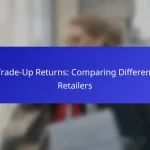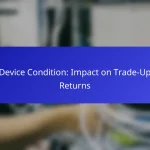How does the Trade-Up Program work?
The Trade-Up Program allows participants to exchange their used items for credit towards new purchases. This process typically involves evaluating the condition of the items, determining their trade-in value, and applying that value to a new purchase.
Step-by-step process overview
The Trade-Up Program generally follows a straightforward process. First, participants submit their items for evaluation, either online or at a designated location. Next, the items are assessed for condition and value, and participants receive an offer based on this assessment.
If the offer is accepted, participants can then apply the trade-in credit towards their next purchase. This process often includes a few simple steps: evaluation, offer acceptance, and purchase application.
Eligibility criteria for participants
To participate in the Trade-Up Program, individuals typically need to meet certain eligibility criteria. Generally, items must be in good working condition and meet specific brand or model requirements.
Additionally, participants may need to provide proof of purchase or ownership. It’s advisable to check the program’s specific guidelines, as these can vary by retailer or brand, and may include restrictions on the types of items accepted.
What are the benefits of the Trade-Up Program?
The Trade-Up Program offers significant advantages, including increased value for your trade-ins and access to newer models. This program allows consumers to upgrade their devices while maximizing their investment.
Increased value for trade-ins
The Trade-Up Program typically provides higher trade-in values compared to traditional resale methods. This is often due to partnerships with manufacturers that streamline the process and reduce overhead costs.
For example, you might receive a trade-in value that is 20-30% higher than what you would get from selling your device privately. This can make a substantial difference when upgrading to a new model.
Access to newer models
Participating in the Trade-Up Program gives you the opportunity to acquire the latest models without the burden of full retail prices. This is particularly beneficial for tech enthusiasts who want to stay current with advancements.
Many programs allow you to trade in your old device and receive immediate credit towards the purchase of a new one. This can make the transition to newer technology smoother and more affordable.
What items are eligible for trade-up?
Eligible items for trade-up typically include smartphones, tablets, laptops, and other electronic devices that meet specific criteria. These devices must be in working condition and meet the brand and model requirements set by the trade-up program.
Accepted brands and models
Most trade-up programs accept a variety of popular brands such as Apple, Samsung, Google, and Microsoft. Specific models may vary by program, so it is essential to check the trade-up provider’s website for a complete list of accepted devices.
For example, recent models like the iPhone 12 and Galaxy S21 are often eligible, while older models may not qualify. Always verify the exact model number to ensure eligibility.
Condition requirements for devices
Devices must generally be in good working condition to qualify for trade-up. This means they should power on, have functional screens, and not exhibit significant physical damage.
Common requirements include having a battery that holds a charge and no major scratches or dents. Some programs may also require that devices be factory reset and free of personal data before submission.
How to initiate a Trade-Up request?
To initiate a Trade-Up request, you need to follow a straightforward process that typically involves submitting an online form. This request allows you to exchange your current items for upgraded versions, often at a reduced cost.
Online submission process
The online submission process for a Trade-Up request usually begins on the company’s official website. You will need to locate the Trade-Up section and fill out the required form, which may include details about the items you wish to trade and the items you want in return.
After submitting your request, you can expect a confirmation email outlining the next steps. This may include instructions for shipping your items or additional verification requirements.
Required documentation and information
When submitting a Trade-Up request, you will typically need to provide specific documentation and information. This may include proof of purchase for the items you are trading, along with their condition and any serial numbers.
Additionally, be prepared to include your contact information and any preferences regarding the items you wish to receive. Ensuring you have all necessary details ready can expedite the process and help avoid common pitfalls, such as delays or rejections of your request.
What are the shipping and return policies?
The shipping and return policies for trade-ins are designed to ensure a smooth process for customers. Understanding these policies can help you navigate the trade-up program effectively and avoid unexpected issues.
Shipping options for trade-ins
When participating in a trade-up program, you typically have several shipping options for sending your items. Most programs offer prepaid shipping labels, allowing you to send your trade-ins at no additional cost. Alternatively, you may choose to ship items using your preferred carrier, but you will need to cover those shipping expenses.
It’s important to check the specific guidelines of the trade-up program you are using, as some may have restrictions on shipping methods or require items to be sent within a certain timeframe. Always package your items securely to prevent damage during transit.
Return policy for traded items
The return policy for traded items usually allows you to return items within a specified period if they do not meet your expectations. Commonly, this period ranges from 14 to 30 days, but it can vary by program. Ensure you keep the original packaging and any included accessories, as these may be required for a full refund.
Before initiating a return, review the program’s specific conditions, as some items may be ineligible for return based on their condition or type. Always contact customer service for clarification if you are unsure about the return process.
How is the trade-in value determined?
The trade-in value is determined based on various factors, including the condition of the item, its age, and current market demand. Evaluators assess these elements to provide a fair value that reflects what buyers are willing to pay.
Factors influencing valuation
Several key factors influence the valuation of a trade-in. The item’s physical condition, such as scratches or functionality, plays a significant role. Additionally, the original purchase price and any included accessories can affect the overall value.
Another important aspect is the age of the item. Generally, newer models tend to have higher trade-in values compared to older ones. For example, a smartphone that’s less than a year old may fetch a significantly higher price than a model that’s three years old.
Market trends and pricing
Market trends greatly impact trade-in pricing. Seasonal demand can cause fluctuations; for instance, electronics may see higher values during holiday seasons. Keeping an eye on these trends can help sellers time their trade-ins for maximum value.
Additionally, online platforms often provide real-time pricing data that reflects current market conditions. Sellers can use these resources to gauge the average trade-in values and make informed decisions. It is advisable to compare offers from different trade-in services to ensure the best deal.
What are common questions about the Trade-Up Program?
The Trade-Up Program often raises several common questions regarding its processes and benefits. Understanding these inquiries can help customers navigate their options effectively and make informed decisions.
Frequently asked questions
Many customers wonder how the Trade-Up Program works and what items are eligible for trade-in. Typically, customers can trade in their used devices for credit towards new purchases, which can significantly reduce costs. It’s essential to check the specific eligibility criteria and the condition requirements for the items you wish to trade.
Another common question involves the valuation process. Customers often want to know how their trade-in value is determined. This usually depends on the item’s condition, age, and market demand, so values can vary widely. It’s advisable to get an estimate before proceeding with the trade-in.
Customer support resources
If you have questions or need assistance with the Trade-Up Program, various customer support resources are available. Most companies offer dedicated support lines and online chat options for immediate help. Additionally, you can find FAQs and guides on the official website that address common concerns.
For more complex issues, consider reaching out via email or social media channels. These platforms often provide timely responses and can guide you through specific problems related to your trade-up experience. Always keep your order details handy to expedite the support process.
What are the future trends in Trade-Up Programs?
Future trends in Trade-Up Programs are increasingly shaped by technological advancements and evolving consumer preferences. These programs are becoming more streamlined and user-friendly, enhancing the overall trade-in experience for customers.
Emerging technologies in trade-in processes
Technological innovations are transforming trade-in processes, making them faster and more efficient. For example, artificial intelligence is being used to assess the value of traded items accurately, while mobile apps facilitate instant evaluations and transactions.
Blockchain technology is also gaining traction, providing transparency and security in trade-in transactions. This can help build trust between consumers and retailers, ensuring that both parties are satisfied with the trade-in process.
Market shifts and consumer behavior changes
Market dynamics are shifting as consumers increasingly prioritize sustainability and value retention. Many customers are now more inclined to trade in their devices rather than dispose of them, driven by environmental concerns and the desire to offset costs on new purchases.
Additionally, the rise of subscription services and leasing options is influencing how consumers approach ownership. This trend encourages more frequent trade-ins, as consumers look to upgrade their devices regularly without the burden of long-term ownership.







